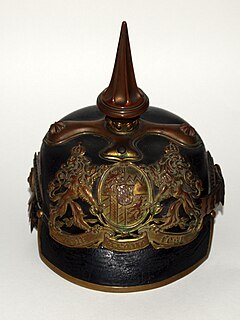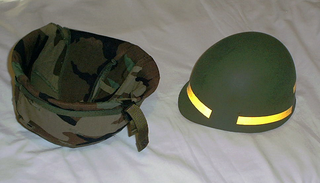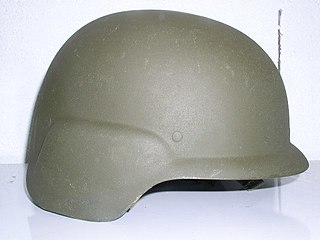
The Pickelhaube, also Pickelhelm, is a spiked helmet worn in the 19th and 20th centuries by German military, firefighters, and police. Although typically associated with the Prussian Army, which adopted it in 1842–43, the helmet was widely imitated by other armies during this period. It is still worn today as part of ceremonial wear in the militaries of certain countries.

A motorcycle helmet is a type of helmet used by motorcycle riders. The primary goal of a motorcycle helmet is motorcycle safety – to protect the rider's head during impact, thus preventing or reducing head injury and saving the rider's life. Some helmets provide additional conveniences, such as ventilation, face shields, ear protection, intercom etc.

The Brodie helmet is a steel combat helmet designed and patented in London in 1915 by John Leopold Brodie. A modified form of it became the Helmet, steel, Mark I in Britain and the M1917 Helmet in the U.S. Colloquially, it was called the shrapnel helmet, battle bowler, Tommy helmet, tin hat, and in the United States the doughboy helmet. It was also known as the dishpan hat, tin pan hat, washbasin, battle bowler, and Kelly helmet. The German Army called it the Salatschüssel. The term Brodie is often mis-used. It is correctly applied only to the original 1915 Brodie's Steel Helmet, War Office Pattern.

Personnel Armor System for Ground Troops is a combat helmet and ballistic vest that was used by the United States military from the early 1980s until the mid-2000s, when the helmet and vest were succeeded by the Lightweight Helmet (LWH), Modular Integrated Communications Helmet (MICH), and Interceptor Body Armor (IBA) respectively.

The M1 helmet is a combat helmet that was used by the United States military from World War II until 1985, when it was succeeded by the PASGT helmet. For over forty years, the M1 was standard issue for the U.S. military. The M1 helmet has become an icon of the American military, with its design inspiring other militaries around the world.

The M15 Adrian helmet was a combat helmet issued to the French Army during World War I. It was the first standard helmet of the French Army and was designed when millions of French troops were engaged in trench warfare, and head wounds from the falling shrapnel generated by the new technique of indirect fire became a frequent cause of battlefield casualties. Introduced in 1915, it was the first modern steel helmet and it served as the basic helmet of many armies well into the 1930s. Initially issued to infantry soldiers, in modified form they were also issued to cavalry and tank crews. A subsequent version, the M26, was used during World War II.

The pith helmet, also known as the safari helmet, sun helmet, topee, sola topee or topi, is a lightweight cloth-covered helmet made of sholapith. Pith helmets were often worn by European travelers and explorers, in the varying climates found in Africa, Southeast Asia, and the tropics, but have also been used in many other contexts. They were routinely issued to European military personnel serving overseas "in hot climates" from the mid-nineteenth to the mid-twentieth century.
The Modular Integrated Communications Helmet (MICH) is a U.S. combat helmet and one of several used by the U.S. military. It was developed by the United States Army Soldier Systems Center to be the next generation of protective combat helmets for use by the U.S. Army.

The SPECTRA helmet or CGF Gallet Combat Helmet is the ballistic helmet in use with the French military, and the armies of several other countries. Built by CGF Gallet, it weighs 1.4 kg (3.1 lb), is available in three sizes, and is made from ultra-high-molecular-weight polyethylene Spectra fibers, produced under license from Honeywell.

The winged football helmet is a helmet bearing a distinctive two-toned painted design that typically has sharp outward curves over the forehead forming a wing. It is worn by many high school and college American football teams, most popularly by the University of Michigan Wolverines.
A welding helmet is a type of headgear used when performing certain types of welding to protect the eyes, face and neck from flash burn, ultraviolet light, sparks, infrared light, and heat.

The Mk 6 helmet was the standard combat helmet of the British Armed Forces as well as another supplied helmet of the UN during peacekeeping operations. The Mk 6 replaced the Mk IV helmet in army service and the RAC helmet in naval service. The jump in MK numbers is thought due to the confusion surrounding the MK IV helmet using the MK V lining, introduced in 1959. The MK 6, introduced into service from 1985, is designed to accept modern ear protection, Bowman personal radios, and respirators. The helmet is manufactured by NP Aerospace, and is reported to have an "almost unlimited service life" by the manufacturer.

Bell Sports, a division of Vista Outdoor, is an American maker of bicycle and motorcycle helmets. BRG Sports, owner of Riddell football helmets, sold the Bell, Giro, C-Preme, and Blackburn brands to Vista in 2016.

The Modèle 1951 helmet was a military helmet used by the French military, iconic of the Algerian War. It replaced a variety of helmets used during the Second World War, including the Adrian helmet, Modèle 1945 helmet and American-supplied M1 Helmet.

The Enhanced Combat Helmet (ECH) is a U.S. Army program to replace the combat helmets of the U.S. Army, Air Force, Navy, and Marines using thermoplastics instead of the ballistic fibers used on the current generation combat helmets. The term "Enhanced Combat Helmet" was originally coined by Army Lieutenant Colonel William R. Schaffer.

The Workers and Socialist Party (WASP) is a Marxist and Trotskyist political party in South Africa affiliated to the Committee for a Workers' International.
The M63 is a combat helmet of South African origin. Based on the French Modèle 1951 helmet, the M63 replaced the British type Brodie helmets during the early 1960s, and saw extensive use during the Rhodesian and Angolan bush wars. It was issued until the 1980s when it was replaced by the M87 kevlar helmet.

The 2017 Arizona Wildcats football team represented the University of Arizona during the 2017 season. The season was the Wildcats's 118th overall, 40th as a member of the Pac-12 Conference, seventh within the Pac-12 South Division, and the sixth and final year under head coach Rich Rodriguez. The team played their home games at Arizona Stadium in Tucson, Arizona for the 89th straight year.

The Gefechtshelm M92 is the standard issue combat helmet of the Bundeswehr, first fielded in 1992 as a replacement of earlier steel helmets that were previously used during the Cold War. It is made from Aramid composite materials and is used by all branches of the Bundeswehr.


















